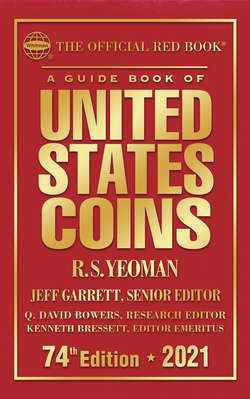Читать книгу A Guide Book of United States Coins 2021 - R.S. Yeoman - Страница 29
PRE-FEDERAL ISSUES COLONIAL ISSUES FOREIGN COINS IN THE COLONIES
ОглавлениеMoney had a rich history in America prior to the advent of the United States’ national coinage in 1793. When coins tumbled off the presses from the first Philadelphia Mint the country was much more accustomed to coins from other lands. Prior to 1652 there was no local coinage and the only money in circulation was whatever came here from Europe through trade or travel. People were content to use currency, both old and new, whose value was based more on the metal content than on the issuer’s reliability. Foreign money in America during the colonial period had become so embedded that it continued to be accepted as legal tender until discontinued by the Coinage Act of February 21, 1857. Coins of this era are so fundamental to American numismatics that every collection should include at least a sampling.
From the very beginning of commerce in America “hard money” was needed for trade with overseas nations. The largest quantity of coinage consisted of English crowns, shillings, and pence, and Spanish and Spanish-American silver pieces of eight, all of which circulated throughout colonial settlements until being sent back to England for critically needed supplies. Additional quantities of coins came from trading furs, lumber, and other exports that provided a limited but much needed supply of hard currency. Of equal importance to commerce were similar coins of other European countries. The large silver Dutch leeuwendaalder (Lyon or Lion dollar) and French écu saw extensive circulation, as did the Brazilian gold peças. Some New York bills of 1709 were even denominated in Lyon dollars. Distinguishing between the relative values of the multitude of different foreign currencies was not a simple task. To facilitate conversions, books and tables showed comparison prices for each currency.
The popular Spanish-American silver eight reales, Pillar dollar, or piece of eight, which was a radical departure from denominations in terms of English pounds, shillings, and pence, became a model for the American silver dollar, and its fractional parts morphed into the half-dollar and quarter-dollar coins that are now considered decimal fractions of the dollar. The American quarter dollar, which was similar in size and value to the Spanish two-real coin, took on the nickname “two bits”—a moniker that remains today. Similarly, the American one-cent coin has never totally lost its association with the English penny, and is still called that by anyone indifferent to numismatic accuracy.
Coins, tokens, paper money, and promissory notes were not the only media of exchange used during the early formation of the country. Many day-to-day transactions were carried on by barter and credit. Mixed into this financial morass were local trade items such as native wampum, hides, household goods, and tools. Records were kept in the traditional English pounds, shillings, and pence, but debts and taxes were paid in corn, beaver pelts, or money—money being whatever foreign coins were available. The terms “country pay” or “corn” referred to a number of different kinds of grain or even peas. Standard exchange rates were established and country pay was lawfully received at the colonial treasury for taxes.
Beyond these pre-federal considerations are the many kinds of private and state issues of coins and tokens that permeate the colonial period from 1616 to 1776. These are items that catch the attention and imagination of everyone interested in the history and development of early America. Yet, despite their enormous historical importance, forming a basic collection of such items is not nearly as daunting as one might expect.
The coins and tokens described in the next three sections of this book are fundamentally a major-type listing of the metallic money used throughout the pre-federal period. Many collectors use this as a guide to forming a basic set of these pieces. It is not encyclopedic in its scope. Beyond the basic types are numerous sub-varieties of some of the issues, and a wider range of European coins. Some collectors aim for the finest possible condition, while others find great enjoyment in pieces that saw actual circulation and use during the formative days of the country. There are no rules about how or what to collect other than to enjoy owning a genuine piece of early American history.
